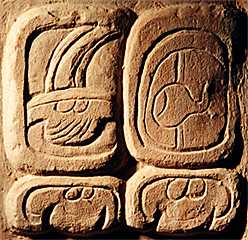|
At the 1998 Texas Meetings, Nikolai Grube said with regard to the top collocation on the right above: "We know that that the main sign is a logogram that must refer somehow to places or to certain locations which were extremely important like palaces or temples. In the past, various people, including Linda Schele, Barbara MacLeod, and myself have read this sign as kun. We based our reading on an obscure entry in a dictionary that described kun as a word for "platform". We thought that this sign substituted for an owl head which represents the word ku for the word kun. So we believed that this sign had to be read kun; however, there is no good evidence for the kun reading. The owl head which can substitute for this main sign always has some additional sign in front of the beak. All we know is that this word ends in na. We simply refer to this sign as the impinged bone glyph." (The glyph appears in several variants, one of which has "bone" motif. The variant above is sometimes also refered to as the "impinged eyeball". One half of the glyph is often crosshatched, as if the eye were looking out from inside a cave.) To which Barbara MacLeod responded: "We should ask David Stuart because he has offered an alternative reading here. He thinks that this glyph might read ch'en." Grube: "The problem with the ch'en reading is that we have statements like puluy "to burn" going with this verb. You cannot burn a ch'en or a "well." MacLeod: "It depends on whether this activity is taking place within a cave." (Grube and Martin 1998.) At the 2000 Texas Meetings, Grube and Simon Martin were reading this glyph as ch'een. (The double-e represents the vowel complexity suggested by the disharmonic suffix -na. Some epigraphers think that the complexity is better represented by the spelling ch'e'en.)
|

